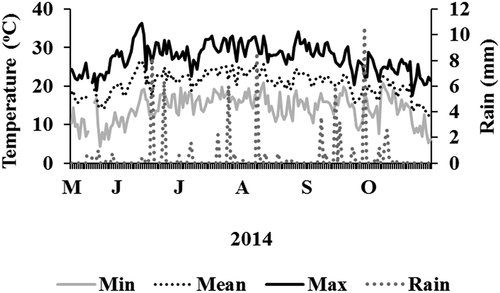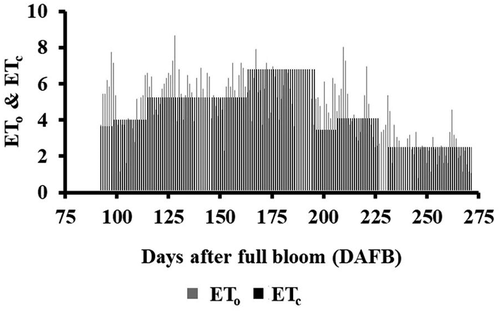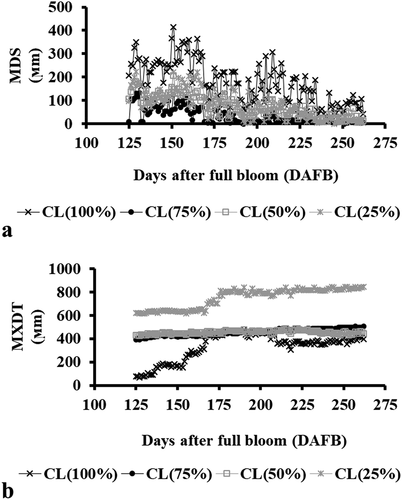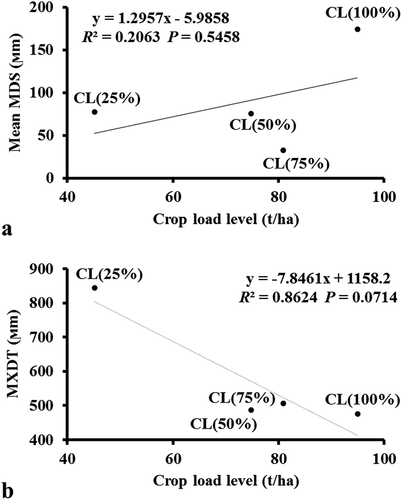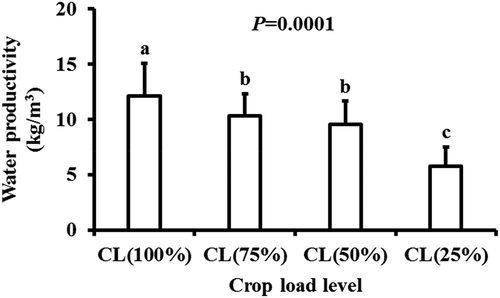ABSTRACT
This study aimed to evaluate the effects of different crop load levels on apple trees’ yield and physiological characteristics, emphasizing the relationship between stem water potential and crop load and the link between trunk diameter growth and crop load. It was conducted in 2014 at Station Expérimentale Fruits et Légumes (SUDEXPE-CEHM) in Southern France. The ‘JoyaTM’ apple on Pajam-1 rootstock was used as the plant material. Trees were subjected to hand thinning to obtain four final crop load levels as high (100%; 10 fruit/cm2 of branch cross-sectional area (BCSA)), medium-high (75%; 7.5 fruit/cm2 of BCSA), medium-low (50%; 5 fruit/cm2 of BCSA) and low (25%; 2.5 fruit/cm2 of BCSA). The four crop load levels were set up in a randomized block design with four replications, and each plot was formed of five uniform trees. Stem water potential was weakly affected by crop load but was mainly driven by vapor pressure deficit. The maximum daily trunk diameter, by and large, reduced while crop load level increased. The increase in crop load level was negatively related to fruit size, acidity and soluble solids content. Crop load did not affect bitter pit incidence. However, in parallel to the increasing crop load level, cumulative yield, yield efficiency and water productivity increased.
Introduction
The primary goal in fruit growing is to access as maximum yield as possible of better-quality crops at minimum cost (Westwood, Citation1995). Crop load management is a pivotal practice to reach this target. It influences many physiological processes in fruit orchards such as source-sink carbon relationships, water status and water consumption (Bustan et al., Citation2016). The fruit are strong carbohydrate sink, and high crop load levels can stunt the vegetative growth (Yuri et al., Citation2011) and return bloom of trees (Elsysy and Hirst, Citation2017).
The low crop load manipulates the tree to promote secondary growth in perennial plants (Lauri et al., Citation2010). Apple growers set crop load, as a vigor control tool, to bend the main leader and lateral branches down, especially in the training systems for high-density apple orchards such as Centrifugal Training, to achieve the balance between vegetative growth and fruiting (Atay, Citation2016). Thus, high crop load levels deplete nutrients in plants and especially carbohydrates required for vegetative growth (Goldschmidt, Citation1999).
Crop load management regulates regular annual cropping, next season’s crop potential, vigor and fruit characteristics (Beya-Marshall and Fichet, Citation2017; Yuri et al., Citation2011). However, after physiological fruit drop, crop load adjustment by thinning has no or little effect on next season’s crop potential because of already established flower initiation (Westwood, Citation1995).
Setting up an optimized crop load level can allow a correct size and quality for fruit. High crop load levels can penalize fruit quality, and therefore crop’s market value. Dry matter accumulation, firmness, sugars and acidity in the fruit can decrease under high crop load levels (Atay, Citation2017; Serra et al., Citation2016). The fruit are relatively better colored in low yield trees (Gonzalez et al., Citation2020). There is a strong negative correlation between tree yield and fruit size (Forshey et al., Citation1992). High crop load extends ripening (Atay et al., Citation2017). Leaf and fruit nutrient concentrations can be affected by crop load (Neilsen et al., Citation2015). Reig et al. (Citation2018) found that leaf and fruit minerals are moderate to low, correlate with cumulative crop load in ‘Fuji’ apple grafted on different rootstocks under New York conditions. Low crop load levels can increase physiological and storage disorders via increasing vegetative growth (Serra et al., Citation2016; Wünsche and Ferguson, Citation2005). As crop load increased in ‘Golden Delicious’/M.9 apple, potassium and manganese concentrations in the leaf decreased correspondingly (Atay, Citation2016).
In that context, for a long time, fruit growers have sought to understand how crop load changes the yield and fruit quality characteristics of trees. With this background, our study aimed at evaluating tree water status, physiological and yield responses of ‘JoyaTM’ apple under varied crop load levels from low to high.
Materials and methods
Experimental site and plant materials
This study was conducted in 2014 in an experimental orchard at Station Expérimentale Fruits et Légumes (SUDEXPE-CEHM; http://www.sudexpe.net/), located in Marsillargues in the South-East Mediterranean region of France (latitude 43° 37ʹ N – longitude 4° 09ʹ E – altitude 5 m). The area has a Mediterranean climate (). The soil of the orchard plot was the clay-loam texture. The ‘Fuji’ trees on ‘Pajam-1ʹ rootstock were planted at 4 m × 2 m spacing (1250 trees per ha) in 1994. The trees regrafted from ‘Fuji’ to ‘JoyaTM’ in 2005. ‘JoyaTM’ (formerly as known as ‘Cripps Red’ and ‘SundownerTM’), a very late season cultivar, was bred by Western Australian breeding programme (Cripps et al., Citation1993). It has the same parentage (‘Lady Williams’ x ‘Golden Delicious’) as Cripps Pink (‘Pink Lady®’) (Brown and Maloney, Citation2003). It is bitter pit prone cultivar and has a regular bearing pattern. Trees were trained to a Biaxis Centrifugal System since grafting (Lauri et al., Citation2004). The orchard was irrigated daily (4 pulses a day) at 100% of the estimated crop evapotranspiration (ETc). ETc based on the replacement of reference evapotranspiration (ETo) (). Irrigation at ETo was controlled thanks to soil moisture content probes (Decagon EC-5 probes, Decagon Devices, inc., Pullman, USA) inserted at two depths (30 and 60 cm) the soil. The four crop load levels (see below) were displayed in a randomized block design with four replications, including five uniform, possibly adjacent, trees. The three central trees were considered experimental, and two exterior trees functioned as borders, yielding to 12 (3 × 4) experimental trees per crop load level. In 2014, all trees in the orchard were chemically thinned by ammonium thiosulfate (ATS) (Floristar®, Agronutrition, France). Agricultural practices other than crop load management were provided according to commercial procedures in the region.
Crop load levels
Following the physiological fruit drop, ending at the beginning of June in our study, trees were subjected to hand thinning to obtain four final crop load levels as high [100%; CL(100%)], medium-high [75% of High; CL(75%)], medium-low [50% of High; CL(50%)] and low [25% of High; CL(25%)] set at 10, 7.5, 5 and 2.5 fruit/cm2 of branch cross-sectional area (BCSA) using a hand-thinning gauge (Equilifruit, MAFCOT, France) (Kon and Schupp, Citation2013). Crop load adjustments were applied to all lateral branches on the trees.
Data collection
Stem Water Potential (SWP): As a proxy of tree water status, leaf water potential at noon was measured, following protocols established previously by Corell et al. (Citation2013) and Naor et al. (Citation2008). Measurements were performed by a pressure chamber (Arimad-3000; Plant Water Potential Measurement Device for Agriculture, Israel). Before the measurements, selected leaves from the outer part of the canopy (as possible) were covered with an aluminum foil (at least 1 hour before measurements) to ensure equilibrium between leaf and stem. Vapor pressure deficit (VPD) as the measure of the air’s drying power (Murray, Citation1967) was evaluated to check whether it affects SWP.
Trunk diameter growth: Over the growth season (125 DAFB (2/8) and 262 DAFB (17/12) included), the micrometric trunk diameter fluctuations were measured with a dendrometer (Ecomatik, Dachau/Munich, Germany) on a single tree per treatment. Data were monitored at 15 min intervals via an Internet-of-Things (IoT) sensor networks of Sud Agro Météo (SAM; http://www.sudagrometeo.fr/). Maximum daily trunk shrinkage (MDS) and maximum daily trunk diameter (MXTD) were calculated following procedures of Garcia-Garcia-Tejero et al. (Citation2012) and Goldhamer and Fereres (Citation2001). Briefly, MDS was the difference between the maximum and minimum daily trunk diameter values, and MXTD was the maximum trunk diameter value over a 24-h cycle.
Yield: The fruit from each tree were harvested separately by three pickings (230 DAFB (15/11), 243 DAFB (28/11) and 255 DAFB (10/12)) in 2014. Yield (t/ha) and yield efficiency as kg/cm2 trunk cross-section area (TCSA) were calculated. TCSA was computed by the following formula: TCSA = π (trunk diameter/2)2.
Water productivity: Irrigation water productivity was calculated kg/m3 by using irrigation input and yield values.
Fruit growth dynamics: The fruit diameter was measured eleven times by a digital caliper between the dates on 79 DAFB (17/6) and 221 DAFB (6/11). For this, twenty randomly selected fruit (i.e. 20 × 4 = 80 fruit per crop load level) in terminal position were used for each replication.
Fruit quality: The fruit quality characteristics analyzed here have been described elsewhere (Atay et al., Citation2017). In summary, average fruit weight of all crop harvested was determined by dividing yield (kg/tree) to fruit number (fruit number/tree). At each picking, all fruit per tree were graded in terms of diameter (mm) and red color index (%) using an automatic fruit sorting machine (Calibreuse Pomone II 1 L, http://www.maf-roda.com). The starch index, ranging from 1 (high starch) to 10 (high sugar), was scored using CTIFL (France) starch conversion chart to indicate the relative amounts of starch and sugar. The fruit weight (g), titratable acidity (g/L), soluble solids content (SSC) (%), fruit firmness (kg/cm2) and juiciness which is the ratio of the juice to dry matter, were measured using a computer-controlled quality control machine (Setop Giraud Technologie, Pimprenelle, France, www.setop.fr). Bitter pit incidence (%) was calculated using the weight values of fruit with the signs of bitter pit (at least one pit), divided by tree yield.
Data analysis
All statistical analyses were performed using R statistical software version 3.6.2 (R Core Team, Citation2019). When the F-test was significant in the one-way analysis of variance (ANOVA), means were separated using the Least Significant Difference (LSD) test (P < .05) (‘agricolae’ package). The break-point of fruit growth was determined by piecewise linear regression analysis (‘segmented’ package). Regression and correlation analyses were performed to investigate the relationship level among variables. Principal components analysis (PCA) was carried out to investigate relationships among fruit quality characteristics (‘FactoMineR’ package).
Results
Stem water potential
SWP showed no significant differences between crop load levels except at two measurement dates (117 and 130 DAFB). CL(100%) had a higher absolute SWP at 130 DAFB while not at 117 DAFB (). When considering the whole-season, SWP was not affected by the crop load level (). The relationships between SWP and VPD were significant in all crop load levels ().
Figure 3. Midday stem water potentials (SWP, – MPa) of ‘JoyaTM’ apple in 2014 in response to four different crop load levels. (a) SWP values during the growth season (73 DAFB to 166 DAFB included) (n = 8). The values shown are means ± SD. Within each measurement date, asterisks indicate significant differences at P < .05. Full blooming occurs on 30/3. The SWP measurements are performed fourteen times – 73 DAFB (11/6), 80 (18/6), 87 (25/6), 94 (2/7), 101 (9/7), 108 (16/7), 114 (22/7), 117 (25/7), 123 (31/7), 130 (7/8), 137 (14/8), 144 (21/8), 156 (2/9) and 166 (12/9) during the growth season. CL(50%) and CL(25%) have been shown one day before the real-time to achieve clarity. (b) Box plot representations of whole-season SWP values under four different crop load levels (n = 112). The horizontal middle line in boxes, and limits of each box plot, denotes the median value and limits of inter-quartile intervals, respectively. The whiskers below and above the boxes denote the minimum and maximum value, respectively
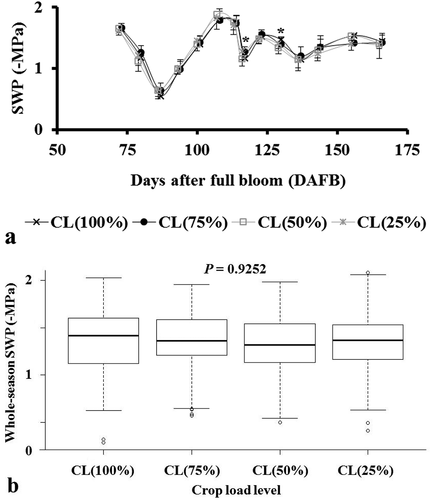
Figure 4. Midday stem water potential (SWP; – MPa) values of four different crop load levels in response to vapor pressure deficit (VPD) on 73 DAFB (11/6), 80 (18/6), 87 (25/6), 94 (2/7), 101 (9/7), 108 (16/7), 114 (22/7), 117 (25/7), 123 (31/7), 137 (14/8), 144 (21/8), 156 (2/9) and 166 (12/9) during the growth season of 2014 (n = 8). VPD values in the figure mean of the values collected from 12:00 to 14:00. The values shown are means ± SD
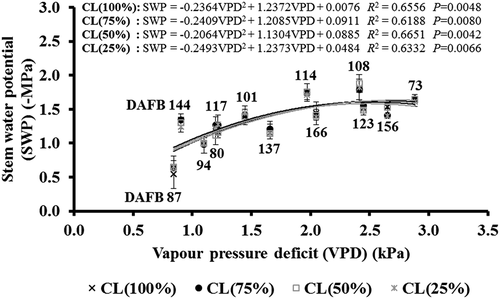
Trunk diameter growth
The MDS did not run in parallel to the crop load level during the growth season (). However, the tendency in MXDT was quite consistent across crop load levels. CL(25%) showed higher MXDT values during the season. It was followed by CL(50%), CL(75%) and CL(100%), respectively. Toward the end of the season, the layout between CL(50%) and CL(75%) had changed (). All relationships between crop load level and MDS () and MXTD () were not significant at P < .05.
Yield and water productivity
CL(100%) had the greatest values for the number of fruit and yield at the second and third harvest as well as in cumulated yield (; ).
Table 1. Number of fruit per tree at each picking time and trunk cross-section area (TCSA) values of trees trained to Biaxis Centrifugal System
Figure 7. Effect of four different crop load levels on the yield of ‘JoyaTM’ apple at each picking time in 2014 (n = 12). Analysis of covariance (ANCOVA) is used for the TCSA (trunk cross-section area) effect on yield at each picking time. Within each picking time, different letters indicate significant differences at P < .05. The values shown are means ± SD
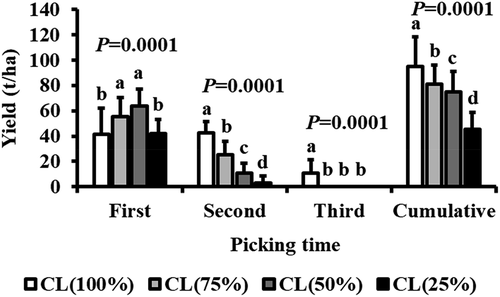
[t] near here[/t].
Yield efficiency was higher in CL(100%) (1.50 ± 0.31 kg/cm2 TCSA), and CL(25%) had the least yield efficiency value (). In parallel with the increased crop load level, water productivity increased ().
Figure 8. Effect of four different crop load levels on the yield efficiency as kg/cm2 TCSA of ‘JoyaTM’ apple in 2014 (n = 12). ANCOVA is used for the TCSA (trunk cross-section area) effect on yield efficiency as kg/cm2 TCSA analysis. Within each crop load level, different letters indicate significant differences at P < .05. The values shown are means ± SD
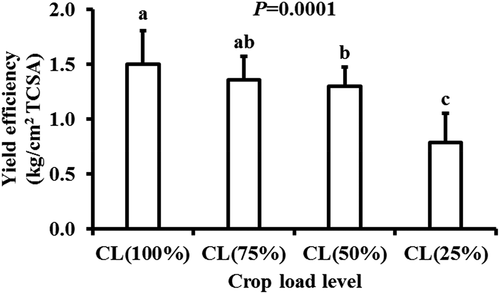
Fruit growth and quality
At the first measurement date, ANOVA analysis confirmed no significant differences in fruit diameters between crop load levels (P = .5278; Data not shown). Except for the first measurement day (79 DAFB (17/6)), the difference between the fruit diameters of the various crop load levels was significant at P < .05. The break-point of fruit growth occurred on 153 DAFB (30/8). On this day, fruit diameter was more considerable in CL(25%), followed by CL(50%), CL(75%) and CL(100%), respectively (). The average fruit weight of all crop harvested was significantly affected by the crop load level, and it was as follows: CL(25%) > CL(50%) > CL(75%) > CL(100%) in descending order ().
Figure 10. The time-course changes of fruit diameter in response to four different crop load levels, (a) CL(100%), (b) CL(75%), (c) CL(50%) and (d) CL(25%), in 2014 (n = 80). Full blooming occurs on 30/3. The diameter measurements are performed eleven times – 79 DAFB (17/6), 87 (25/6), 93 (1/7), 100 (8/7), 108 (16/7), 114 (22/7), 123 (31/7), 131 (8/8), 137 (14/8), 158 (4/9), and 221 (6/11) during the growing season. CL(50%) and CL(25%) have been shown one day before the real-time to achieve clarity. Solid lines represent piecewise linear regression models, and the perpendicular dotted line shows the breakpoint of fruit diameter from the rapid to low fruit growth phase. Within each measurement date, asterisks indicate significant differences at P < .05. The values shown are means ± SD
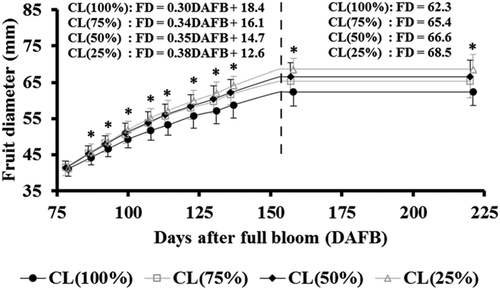
Figure 11. Box plot representations of four different crop load levels on average fruit weight of all crop harvested of ‘JoyaTM’ apple in 2014 (n = 12). The horizontal middle line in boxes, and limits of each box plot, denotes the median value and limits of inter-quartile intervals, respectively. The whiskers below and above the boxes denote the minimum and maximum value, respectively. Different letters indicate significant differences at P < .05
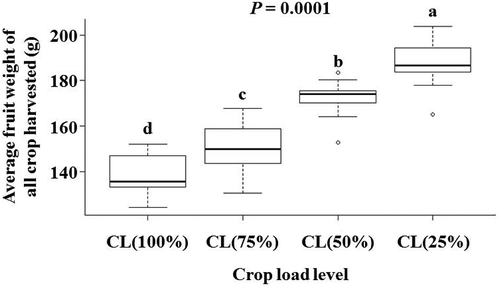
CL(100%) had the greatest yield in 65–70 mm and <65 mm size classes. CL(25%) resulted in higher yields in bigger size classes (>85 mm and 80–85 mm) compared to other crop load levels. Nevertheless, it had a relatively low yield in 70–75 mm and <65 mm size classes, with the lowest yield in 65–70 mm size class. CL(75%) and CL(50%) showed values between the other two extreme crop load levels (). CL(100%) showed the least yield in >85% and 70–85% red color index classes, although it had the greatest yield in 40–55%, 25–40% and <25% classes. CL(50%) showed relatively low yield in 25–40% and <25% red color index classes together with CL(25%). CL(75%) showed moderate values between CL(100%) and CL(50%). CL(25%) had the least yield in 40–55% red color index class ().
Figure 12. Effect of four different crop load levels on yield of ‘JoyaTM’ apple per size class in 2014 (n = 12). Within each crop load level, different letters indicate significant differences at P < .05. The values shown are means ± SD
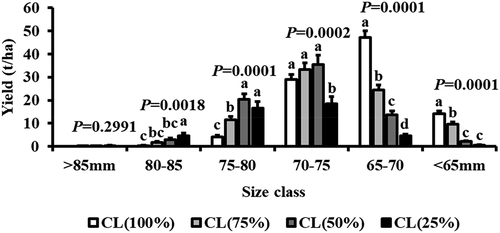
Figure 13. Effect of four different crop load levels on yield of ‘JoyaTM’ apple per red color index class in 2014 (n = 12). Within each crop load level, different letters indicate significant differences at P < .05. The values shown are means ± SD
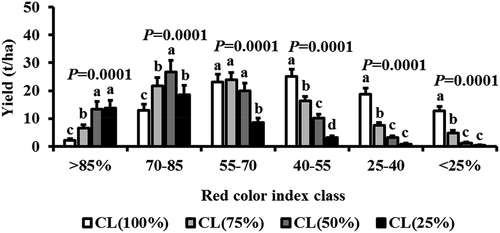
In fruit taken from the most represented size class (70–75 mm in diameter), starch index was the highest in CL(100%) with 8.72 ± 1.30 index range (1–10) (). CL(50%) and CL(25%) showed higher values for the weight () and acidity () in comparison to the other crop load levels. SSC was greatest in CL(25%) with 12.62 ± 0.66%. However, it was least in CL(100%) with 11.46 ± 0.59% (). There were no significant differences between crop load levels for firmness () and juiciness (). The relationship between fruit quality characters is seen in PCA, covering the first two components (). SSC was negatively correlated with the starch index and negatively correlated with fruit weight, firmness and acidity. Fruit weight was negatively correlated with firmness and positively correlated with acidity (). Bitter pit incidence was not related to crop load levels ().
Figure 14. Effect of four different crop load levels on fruit quality characteristics of ‘JoyaTM’ apple in 2014. (a) Starch index (n = 120), (b) weight (n = 240), (c) titratable acidity (n = 8), (d) soluble solids content (SSC) (n = 240), (e) flesh firmness (n = 240) and (f) juiciness (n = 8). Within each crop load level, different letters indicate significant differences at P < .05. Fruit are taken from the most represented fruit size class (70–75 mm in diameter). The values shown are means of the pooled data of first (230 DAFB (15/11)) and second (243 DAFB (28/11)) picking dates±SD
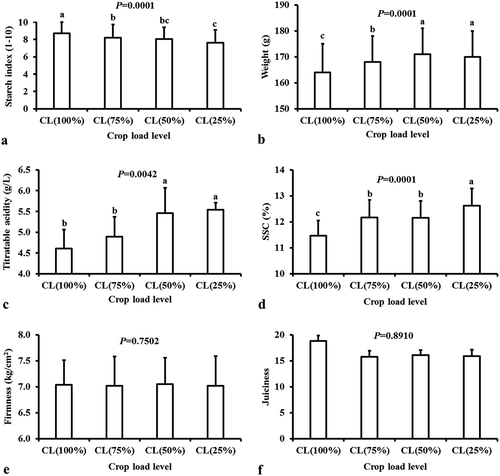
Figure 15. Relationships among starch index, weight, titratable acidity, soluble solids content (SSC), flesh firmness and juiciness of ‘JoyaTM’ apple in 2014. (a) The first two components (PC 1 and PC 2) of PCA, and (b) pairwise correlations that significantly important

Figure 16. Effect of four different crop load levels on bitter pit incidence of ‘JoyaTM’ apple in 2014 (n = 12). A trigonometric-arcsin transformation is used on the percentage of bitter pit values. The values shown are means of the pooled data of first (230 DAFB (15/11)) and second (243 DAFB (28/11)) picking dates±SD
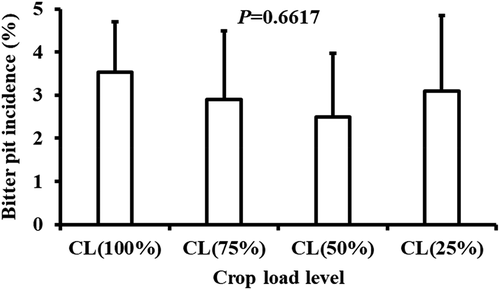
Discussion
Stem water potential and trunk diameter growth
Trees with no fruit show a lower stomatal conductance and transpiration rates than the trees with fruit in deciduous species (DeJong, Citation1986; Hansen, Citation1971). Thus, the higher absolute SWP values are expected at high crop load levels because of the higher transpiration and the high resistance to water flow from soil to the stem (Bustan et al., Citation2016; Naor et al., Citation2008). In our study, crop load did not create a noticeable effect on SWP. Due to stress-free conditions (such as full irrigation (100% of ETc) and proper fertilization) SWP might not have changed significantly in the study orchard. Besides, differences in SWP results between our study and previous studies may be attributed to tree training system we implemented. Leaf samples for SWP measurements are recommended to be taken from the shaded interior part of the tree canopy (Correa-Tedesco et al., Citation2010; Naor et al., Citation2008). Shaded leaves in the interior canopy would be expected to have relatively low stomatal conductance, transpiration and post excision desiccation compared to the outer canopy (Fulton et al., Citation2001). However, in our study, we trained the trees to Centrifugal System. In this training system, buds that are close to the tree trunk are removed. In this study, SWP is driven by VPD. The stomatal closure, and thus SWP, is encouraged by high VPD (Hernandez et al., Citation2016).
The sensors for MXTD monitoring were installed without repetitions. Sensors in commercial orchards are commonly used without any statistical design. In this study, MXTD, in general, decreased with increasing crop load level. MXTD inclined to decrease under water stress, especially during the midsummer period (Cuevas et al., Citation2013). The effect of high crop level inducing an increase in MXTD can be attributed to stimulated water stress.
Yield, water productivity, fruit growth and quality
It is safe to say that increasing crop load level, the number of fruit, cumulative yield, yield efficiency and water productivity increased. However, fruit size, acidity and SSC decreased. Crop load management is one of the most crucial vital practices determining the yield and fruit quality in fruit tree orchards (Anthony et al., Citation2019). Low crop load levels do not increase fruit size, beyond a saturation point (Corelli-Grappadelli and Lakso, Citation2004). High crop load penalizes SSC and coloring due to a shortage of carbohydrate supply and sinks for fruit (Atay, Citation2017; Bustan et al., Citation2016; Robinson et al., Citation2009). Besides, high crop load levels can negatively affect ripening, firmness, sugars and acidity in the fruit (Serra et al., Citation2016). As based on our previous experiences, ‘JoyaTM’ is a bitter pit prone cultivar. There is a relationship between crop load and bitter pit incidence, and relatively low crop load levels can produce large and bitter-pit prone fruit (Wünsche and Ferguson, Citation2005). However, in this study, crop load did not significantly affect on bitter pit incidence. Pajam-1, the rootstock of the trial trees, may have prevented the effect of crop load on the bitter pit incidence from being seen more clearly. Rootstocks can affect fruit nutrient composition and bitter pit susceptibility by affecting the nutrient absorption and distribution of trees (Fazio et al., Citation2020; Reig et al., Citation2018; Valverdi and Kalcsits, Citation2021). Donahue et al. (Citation2021) found no direct relationship between crop load and bitter pit incidence, and rootstock and climatic conditions were influential in the rate of bitter pit incidence.
To conclude, our study conducted in a well-irrigated apple orchard trained to Centrifugal Training in South-East France showed that SWP was not affected by crop load levels whereas VPD did. MXTD was negatively correlated to crop load.
Acknowledgments
This work has been partly funded by the ARIMNET (Coordination of the Agricultural Research in the Mediterranean Area) research program APMed (Apple and Peach in Mediterranean orchards - Integrating tree water status and irrigation management for coping with water scarcity and aphid control), and TÜBİTAK (The Scientific and Technological Research Council of Turkey). We thank anonymous reviewers for their valuable comments and suggestions.
Disclosure Statement
The authors declare that they have no known competing financial interests or personal relationships that could have appeared to influence the work reported in this paper.
References
- Anthony, B., S. Serra, and S. Musacchi. 2019. Optimizing crop load for new apple cultivar. WA38”. Agronomy, 9(2), 107. DOI: https://doi.org/10.3390/agronomy9020107. 2073-4395 (Print).
- Atay, E. 2016. Which nutrients in the leaf decrease linearly as fruit load increases in apples? A preliminary study. Presented at International Academic Research Congress, Antalya, Turkey, June 2016, 656-659. Koksal, O (eds.), Pegem Akademy. e-ISBN 978-605-318-752-3.
- Atay, E. 2017. A new insight into pruning strategy in the biennial cycle of fruiting: Vegetative growth at shoot and whole-tree level, yield and fruit quality of apple. Notulae Botanicae Horti Agrobotanici Cluj-Napoca. 45(1):232–237. doi:https://doi.org/10.15835/nbha45110527. 0255-965X. 0255-965X (Print).
- Atay, E., B. Hucbourg, A. Drevet, and P.E. Lauri. 2017. Investigating effects of over-irrigation and deficit irrigation on yield and fruit quality in Pink LadyTM ‘Rosy Glow’ apple. Acta Scientiarum Polonorum Hortorum Cultus. 16(4):45–51. doi:https://doi.org/10.24326/asphc.2017.4.5. 1644-0692 (Print).
- Beya-Marshall, V., and T. Fichet. 2017. Crop load regulates the next season’s crop potential and fruit components in Frantoio olive trees (Olea europaea L.). Sci. Hortic. 215:149–156. 0304-4238 (Print) doi: https://doi.org/10.1016/j.scienta.2016.11.051.
- Brown, S.K., and K.E. Maloney. 2003. Genetic improvement of apple: Breeding, markers, mapping and biotechnology, p. 31–59. In: D.C. Ferree and I.J. Warrington eds.. Apples: Botany, production and uses. ISBN: 0-85199-592-6. CAB International, CABI Publishing, Cambridge.
- Bustan, A., A. Dag, U. Yermiyahu, R. Erel, E. Presnov, N. Agam, D. Kool, J. Iwema, I. Zipori, and A. Ben-Gal. 2016. Fruit load governs transpiration of olive trees. Tree Physiol. 00:1–12. 1758-4469 (Online) doi: https://doi.org/10.1093/treephys/tpv138.
- Core Team, R., 2019. R: A language and environment for statistical computing. URL. R Foundation for Statistical Computing, Vienna, Austria. https://www.R-project.org/.
- Corell, M., I.F. Giron, A. Moriana, J. Dell’Amico, D. Morales, and F. Moreno. 2013. Extrapolating base-line trunk shrinkage reference equations across olive orchards. Agricultural Water Management 126:1–8. 0378-3774 (Print) doi: https://doi.org/10.1016/j.agwat.2013.04.011.
- Corelli-Grappadelli, L., and A.N. Lakso. 2004. Fruit development in deciduous tree crops as affected by physiological factors and environmental conditions. Acta Hortic. 636(636):425–441. doi:https://doi.org/10.17660/ActaHortic.2004.636.52. 0567-7572 (Print).
- Correa-Tedesco, G., M.C. Rousseaux, and P.S. Searles. 2010. Plant growth and yield responses in olive (Olea europaea) to different irrigation levels in an arid region of Argentina. Agricultural Water Management. 97(11):1829–1837. doi:https://doi.org/10.1016/j.agwat.2010.06.020. 0378-3774 (Print).
- Cripps, J.E.L., L.A. Richards, and A.M. Mairata. 1993. ‘Pink Lady’ apple. HortScience. 28(10):1057. doi:https://doi.org/10.21273/HORTSCI.28.10.1057. 0018-5345 (Print).
- Cuevas, M.V., M.J. Martin-Palomo, A. Diaz-Espejo, J.M. Torres-Ruiz, C.M. Rodriguez-Dominguez, A. Perez-Martin, R. Pino-Mejias, and J.E. Fernandez. 2013. Assessing water stress in a hedgerow olive orchard from sap flow and trunk diameter measurements. Irrigation Science. 31(4):729–746. doi:https://doi.org/10.1007/s00271-012-0357-x. 0342-7188 (Print).
- DeJong, T.M. 1986. Effects of reproductive and vegetative sink activity on leaf conductance and water potential of Prunus persica L. Batsch. Sci. Hortic. 29(1–2):131–137. doi:https://doi.org/10.1016/0304-4238(86)90039-7. 0304-4238 (Print).
- Donahue, D.J., Reig Córdoba, G., Elone, S.E., Wallis, A.E., Basedow, M.R., 2021. ‘Honeycrisp’ Bitter Pit Response to Rootstock and Region under Eastern New York Climatic Conditions. Plants, 10:983. doi:https://doi.org/10.3390/plants10050983. ISSN: 2223-7747.
- Elsysy, M.A., and P.M. Hirst. 2017. The role of spur leaves, bourse leaves, and fruit on local flower formation in apple: An approach to understanding biennial bearing. HortScience. 52(9):1229–1232. doi:https://doi.org/10.21273/HORTSCI12136-17. 0018-5345 (Print).
- Fazio, G., J. Lordan, M.A. Grusak, P. Francescatto, and T.L. Robinson. 2020. I. Mineral nutrient profiles and relationships of ‘Honeycrisp’ grown on a genetically diverse set of rootstocks under Western New York climatic conditions. Sci. Hortic. 266:108477. 0304-4238 (Print) doi: https://doi.org/10.1016/j.scienta.2019.05.004.
- Forshey, C.G., D.C. Elfving, and R.L. Stebbins. 1992. Training and pruning apple and pear trees. American Society for Horticultural Science, Virginia, 166.
- Fulton, A., R. Buchner, J. Walton, J. Walton, C. Gilles, N. Bertagna, J. Walton, and K. Shackel. 2001. Rapid equilibration of leaf and stem water potential under field conditions in almonds, walnuts, and prunes. HortTechnology. 11(4):609–615. doi:https://doi.org/10.21273/HORTTECH.11.4.609. 1063-0198 (Print).
- Garcia-Tejero, I.F., V.H. Duran-Zuazo, J. Arriaga, and J.L. Muriel-Fernandez. 2012. Relationships between trunk- and fruit-diameter growths under deficit-irrigation programes in orange trees. Sci. Hortic. 133: 64–71. 0304-4238 (Print). doi:https://doi.org/10.1016/j.scienta.2011.10.022.
- Goldhamer, D.A., and E. Fereres. 2001. Irrigation scheduling protocols using continuously recorded trunk diameter measurements. Irrigation Science. 20(3):115–125. doi:https://doi.org/10.1007/s002710000034. 0342-7188 (Print).
- Goldschmidt, E.E. 1999. Carbohydrate supply as a critical factor for citrus fruit development and productivity. HortScience. 34(6):1020–1024. doi:https://doi.org/10.21273/HORTSCI.34.6.1020. 0018-5345 (Print).
- Gonzalez, L., E. Torres, G. Avila, J. Bonany, S. Alegre, J. Carbo, B. Martin, I. Recasens, and L. Asin. 2020. Evaluation of chemical fruit thinning efficiency using Brevis® (Metamitron) on apple trees (‘Gala’) under Spanish conditions. Sci. Hortic. 261:109003. 0304-4238 (Print) doi: https://doi.org/10.1016/j.scienta.2019.109003.
- Hansen, P. 1971. The effect of fruiting upon transpiration rate and stomatal opening in apple leaves. Physiol. Plant. 25(2):181–183. doi:https://doi.org/10.1111/j.1399-3054.1971.tb01424.x. 1399-3054 (Online).
- Hernandez, M.J., F. Montes, F. Ruiz, G. Lopez, and P. Pita. 2016. The effect of vapour pressure deficit on stomatal conductance, sap pH and leaf-specific hydraulic conductance in Eucalyptus globulus clones grown under two watering regimes. Ann. Bot. 117(6):1063–1071. doi:https://doi.org/10.1093/aob/mcw031. 0305-7364 (Print).
- Kon, T.M., and J.R. Schupp. 2013. Thinning Tall Spindle apple based on estimations made with a hand-thinning gauge. HortTechnology. 23(6):830–835. doi:https://doi.org/10.21273/HORTTECH.23.6.830. 1063-0194 (Print).
- Lauri, P.E., J.J. Kelner, C. Trottier, and E. Costes. 2010. Insights into secondary growth in perennial plants: Its unequal spatial and temporal dynamics in the apple (Malus domestica) is driven by architectural position and fruit load. Ann. Bot. 105(4):607–616. doi:https://doi.org/10.1093/aob/mcq006. 0305-7364 (Print).
- Lauri, P.E., M. Willaume, G. Larrive, and J.M. Lespinasse. 2004. The concept of centrifugal training in apple aimed at optimizing the relationship between growth and fruiting. Acta Hortic. 636. 35–42. doi: https://doi.org/10.17660/ActaHortic.2004.636.3. 0567-7572 (Print).
- Murray, F.W. 1967. On the computation of saturation vapor pressure. J. Appl. Meteorol. 6(1):203–204. doi: https://doi.org/10.1175/1520-0450(1967)006<0203:OTCOSV>2.0.CO;2.
- Naor, A., S. Naschitz, M. Peres, and Y. Gal. 2008. Response of apple fruit size to tree water status and crop load. Tree Physiol. 28(8):1255–1261. doi:https://doi.org/10.1093/treephys/28.8.1255. 1758-4469 (Online).
- Neilsen, G.H., D. Neilsen, S.H. Guak, and T. Forge. 2015. The effect of deficit irrigation and crop load on leaf and fruit nutrition of fertigated ‘Ambrosia’/‘M.9ʹ apple. HortScience. 50(9):1387–1393. doi:https://doi.org/10.21273/HORTSCI.50.9.1387. 0018-5345 (Print).
- Reig, G., J. Lordan, G. Fazio, M.A. Grusak, S. Hoying, L. Cheng, P. Francescatto, and T. Robinson. 2018. Horticultural performance and elemental nutrient concentrations on ‘Fuji’ grafted on apple rootstocks under New York State climatic conditions. Sci. Hortic. 227:22–37. 0304-4238 (Print) doi: https://doi.org/10.1016/j.scienta.2017.07.002.
- Robinson, T., S. Lopez, K. Lungerman, and G. Reginato. 2009. Crop load management for consistent production of Honeycrisp apples. New York Fruit Quarterly 17:24–28.
- Serra, S., R. Leisso, L. Giordani, L. Kalcsits, and S. Musacchi. 2016. Crop load influences fruit quality, nutritional balance, and return bloom in ‘Honeycrisp’ apple. HortScience. 51(3):236–244. doi:https://doi.org/10.21273/HORTSCI.51.3.236. 0018-5345 (Print).
- Valverdi, N.A., and L. Kalcsits. 2021. Rootstock affects scion nutrition and fruit quality during establishment and early production of ‘Honeycrisp’ apple. Hortscience. 56(2):261–269. doi:https://doi.org/10.21273/HORTSCI15488-20. 0018-5345 (Print).
- Westwood, M.N. 1995. Temperate-zone pomology: Physiology and culture. Third ed. Timber Press, Portland, Oregon.
- Wünsche, J.N., and I.B. Ferguson. 2005. Crop load interactions in apple. Hortic Rev (Am Soc Hortic Sci) 31:231–290. ISBN: 9780471666943 (Print) doi: https://doi.org/10.1002/9780470650882.ch5.
- Yuri, J.A., J. Gonzalez Talice, J. Verdugo, and A. del Pozo. 2011. Responses of fruit growth, quality, and productivity to crop load in apple cv. Ultra Red Gala/MM111. Sci. Hortic. 127(3):305–312. doi:https://doi.org/10.1016/j.scienta.2010.10.021. 0304-4238 (Print).

